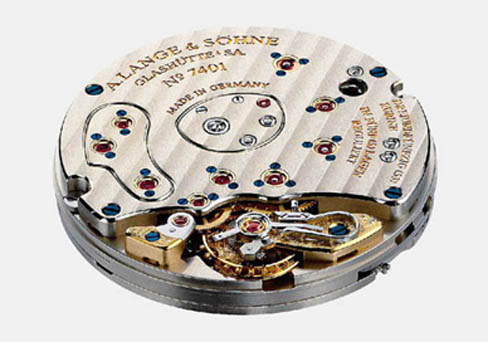This article originally appeared in Timezone forum,
posted by Peter Chong on October 23, 1997 at 15:58:53:
Continuing the thread started in Timezone forum, there was a query on why I
said that the Glashutte movement seems a few notches below the Lange.
To begin, I am not an expert on any of these watches, neither am I a
watchmaker. I am not affiliated to any of these brands. My sole experience
with the Glashutte was about half an hour examining a limited range, lupe in
eye. My interest was mainly on the handwounds. I did this at a shop in
Frankfurt Am Main called Christ, on the main road Kaiserstrasse. I looked
at the 1845 Perpectual in gold, and in steel, and the 1845. Both
these sport the caliber 49 movement.
While I have spent siginificantly
much longer time looking at the Langes, I am, by no stretch of imagination
an expert.
Comparing the Glashutte Perpectual to the Lange 1, as these
appear to be in the same price range: about DM28,000 inclusive of German VAT.
The similarities
The Saxony mark of watchmaking is evident in both watches. The
construction of the movement, examined
under a 15X loupe is similar.
|
Both use the 3/4 plate movement. The use of
this movement was traditionally reserved for pocket watches, where the
caliber is larger. It is extremely difficult to build a wrist-watch with
this large plate, as any small imperfection in the movememt will cause
problems with fit of the clockwork within. In contrast a multi-bridge
approach, used in almost all other watches are more tolerant.
Both use a whiplash micrometer regulator, and a screwed balance wheel.
Both plates are finished with the Glashutte stripes...akin to Geneva
stripes.
Both show exposed rubies with gold chatons held by blued
steel screws.
|  The Glashutte 1845 Ewiger Kalendar The Glashutte 1845 Ewiger Kalendar
|
The differences
The Lange movement is better finished. The edges of the plate is
anglaged and the anglaged edges polished and even. Every pin, wheel, paw, every
piece of the clockwork, even those hidden by the plate is polished to a
very high degree of shine. The hand engraving on the plate is near perfect, with each letter well formed, with equal thickness of the engraving pen (?). The German Silver plates are extremely beautiful.
In contrast, the anglage of the Glashutte is less well done, the degree
of chamfer seems to be unequal at some places, albiet very small. The degree
of polish is less than the Lange. And the engraved letters seem to have
unequal thickness of the pen. Look at the G of Glashutte.
On the Lange plate, two of the three perforations on the 3/4 plate is
covered by another small
plate held by screws. The third perforation reveals a beautifully polished
cogwheel of the movement within.
Even the smaller plates and the openings of the main
plate has polished bevelled edges, known as dicoverture. The Glashutte plate is perforated at 4
locations, 3 of these exposes cog-wheels, and the fourth a paw of the
clockwork within. None of these perforations are
bevelled, nor seem to have been polished.
The rubies on the Lange
look very shiny and perfect in its shape, whilst the ones in the Glashutte
seem quite ordinary. Especially telling is the large ruby of the endstone of the balance wheel.
Also, although this is no indication of the quality
of the movement, the Lange 1 sports 53 jewels, and the Glashutte, though more complicated with the
perpectual calendar is only 28. (or so it says on the catalog, but the
engraving on the plate reads 18 rubies). I think this is a significant flaw, and very sloppy.
The escape cock on the
Lange is hand engraved. The Glashutte reserves engraving only for the
Julius Assmann and the Alfred Helwig, which are on another price catagory.
The case finish is better polished in the Lange than the Glashutte.
The Lange winds very, very smoothly. Creamy. But the Glashutte
winding is ordinary...subjectively, it felt like a Rolex or a GP. Good, but
no cigars...
The Lange has the large innovative double date. Good for older people with
failing eyesight. The Glashutte is an analog perpectual calendar, no doubt
a very useful complication.
The Lange has a power reserve of at least 100 hrs, this is achieved
via the double mainsprings. The Glashutte has a 45 hr power reserve.
I have a copy of the Chronos review of the Glashutte Original 1845.
It is in German, but from what I can see from the score, it receive 4 stars
for overall.
On its own,I would think the Glashutte Perpectual is very well finished, and a very
nice watch. But in comparison to the Lange 1, my vote would go to the A.
Lange & Sohne.
Back to watches
 Go back to home page
Go back to home page
 The Glashutte 1845 Ewiger Kalendar
The Glashutte 1845 Ewiger Kalendar

 Go back to home page
Go back to home page